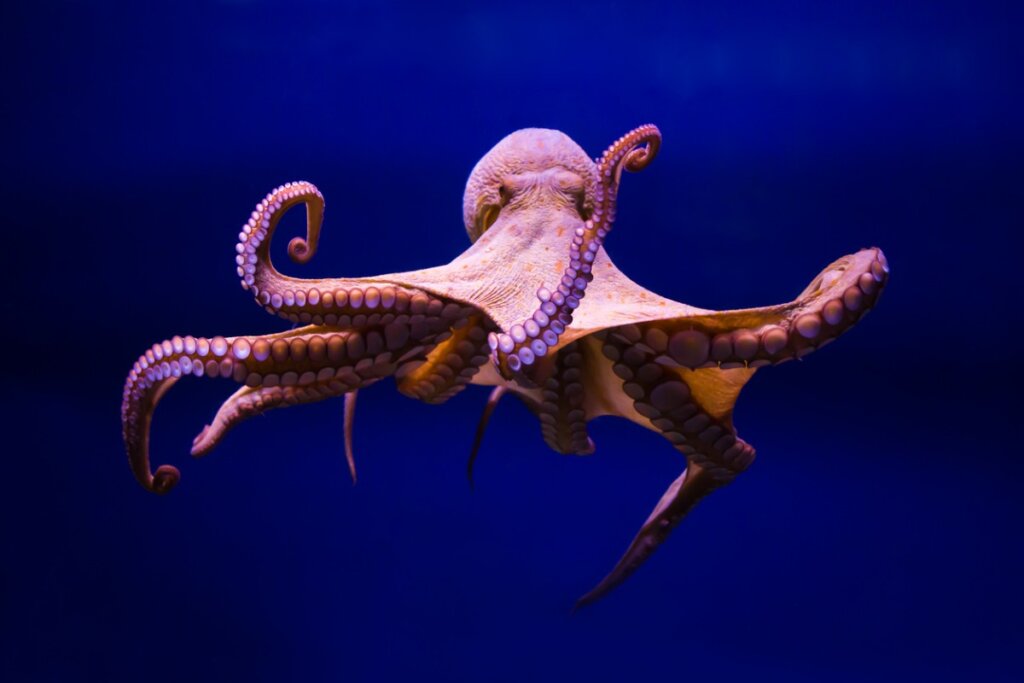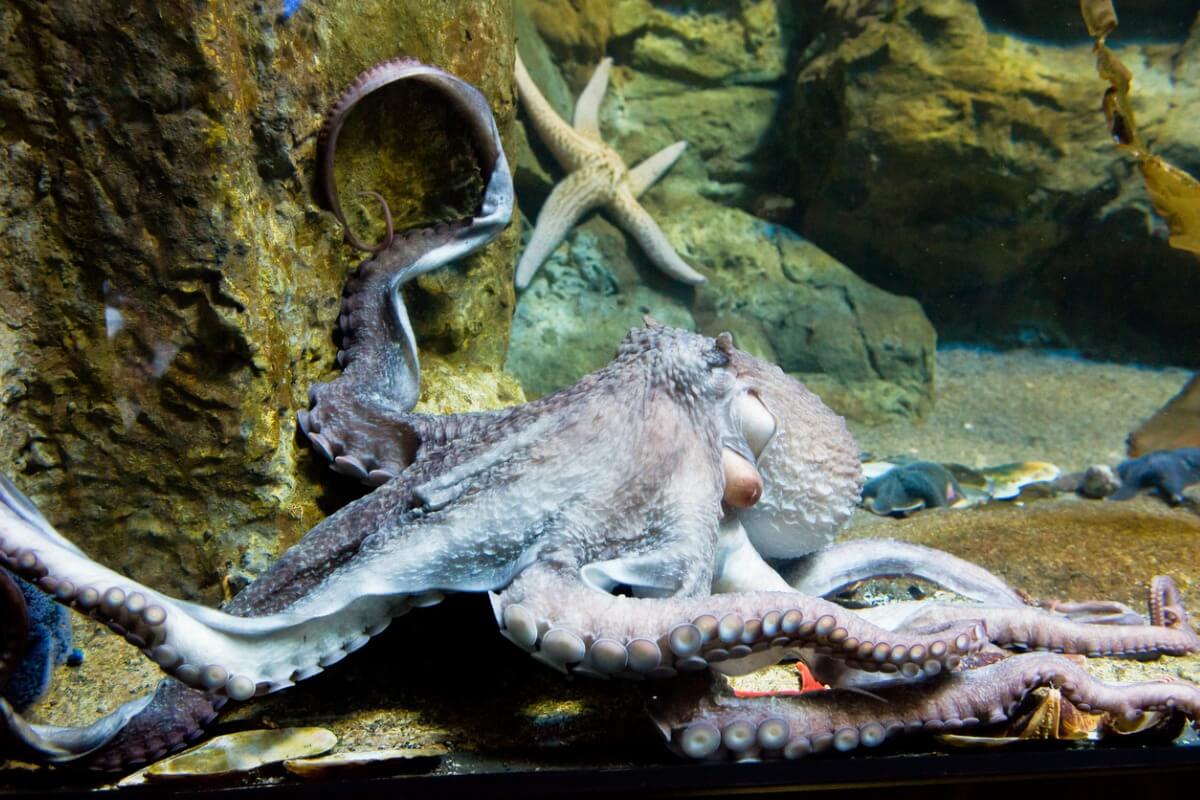How Octopuses Are Born

Octopuses are extraordinary animals and are popular all over the world for a variety of reasons. Their culinary use, their fascinating shape, and the dexterity and intelligence they exhibit are just some of the most obvious. Knowing how octopuses are born is another feature of these animals that are sure to fascinate you (if they don’t already!)
Reproduction in marine animals is by no means easy and octopuses are no exception. Because the care of the eggs by the females is so important, they can even give their lives in order to achieve their goal. Don’t stop reading: here we’ll show you the stages of the reproductive cycle of these cephalopods and how they’re born.
Reproductive characteristics of octopuses
Before knowing how octopuses are born, let’s take a look at some reproductive characteristics of this species. First of all, it’s essential to highlight that these octopods have a short life cycle and usually live for only one or two years.
The time in which these invertebrates reach sexual maturity depends on hormonal and environmental changes. Reproduction can occur within 2 months or they may wait up to a year (depending on the species).
These animals have a variable period of reproductive activity, both for the habitat they occupy and for the specific traits of each specimen. In general, octopuses have been found to reproduce seasonally, especially between spring and summer, as does Octopus minus.
The reproduction of these invertebrates in tropical waters can take place at any time of the year.
Octopuses are dioecious, which means that they have separate sexes and reproduce sexually. To carry out copulation, males have a modified arm called a hectocotylus in which they store the spermatophores they’ll use during the process.
Octopuses reproduce by forming eggs, so they’re classified as oviparous animals. Although they maintain copulatory contact, fertilization is external. These cephalopods go through different stages to fulfill their reproductive purpose, from courtship to the birth of the offspring. Let’s take a closer look at these characteristics in the following paragraphs.

What is courtship like in octopuses?
The courtship stage in octopuses isn’t observed in all their species, but there are good reports of the process in some specimens. Octopus cyanea and Enteroctopus megalocyathus are examples of organisms in which this ritual occurs.
The strategies employed to carry out courtship are fascinating and varied. Among them, we have swimming approaches and short micro-contacts. In addition, it’s common for the male to make changes in his body coloration patterns to impress the female during his very interesting show.
Despite all the efforts made by the male octopuses to mate, it’s the females who make the final decision to accept them or leave to go and look for other suitors. If the female does accept the male, she remains still during the approach of her partner when he’s attempting copulation.
An interesting fact is that these octopod females are promiscuous, that is, they can mate with several males throughout their lives.
Copulation
The copulation process in octopuses is a constant challenge for the males, as the female frequently practices sexual cannibalism. It’s usual to observe this behavior when they’re larger than their mates.
The male octopus runs a great risk at the end of the sexual act: losing their life among the tentacles of his partner.
During the union, the males wrap their arms around the females and introduce their hectocotylus into the paleal cavities of their partners, that is, the areas where they’ll release their spermatophores. Another way to carry out this process is with the copulatory organ extended, as, in this way, the male keeps a prudent distance in case he needs to escape.
Spawning
At the end of copulation, the females look for the right place to lay their eggs and then take care of them with their lives. They usually perform this action in crevices or caves they find among rocks or reefs. The fecundity of most species is high, as they can spawn hundreds of eggs, even thousands. This is the case of the common octopus (O. vulgaris), which lays more than 100,000 eggs.
The eggs are laid in a surprising way: the females place them hanging from the ceiling of the cave she chose, one after the other and in the form of a string. This spectacle is complemented by the fertilization, since while they lay them, the mothers water them with the spermatozoa that she kept during copulation.
Birth of the octopuses
Up to this point, the reproduction of the octopuses is hard work. However, the female still has a lot to do, as she has to take care of the eggs until they hatch.
The development time of the embryo varies (according to temperature and species), but is usually 1 to 4 months. However, there are exceptions, such as the Graneledone boreopacifica octopus, whose gestation lasts up to 53 months on average.
Females don’t feed during this stage and only live to take care of their future offspring. When hatching begins, in most cases they die exhausted after fulfilling their task.
At the end of this long reproductive process, the young octopuses hatch from the eggs that the female has nursed to death. The newly-hatched young are a miniature replica of the adults. They have their 8 arms and are ready to start feeding on microscopic animals, such as zooplankton.
As the young grow and develop, they begin to capture larger prey.
Unlike other mollusks, octopuses don’t undergo any metamorphosis process, but grow quickly until they reach the size of the species they belong to. It’s worth noting that the young are called paralarvae.
The way octopuses are born and their entire reproductive process is amazing and full of incredible events. From the moment they’re ready to reproduce, they begin a series of processes during which they could lose their lives (both males and females). The offspring are a miniature replica of their parents and are born ready to feed and populate the seas.
All cited sources were thoroughly reviewed by our team to ensure their quality, reliability, currency, and validity. The bibliography of this article was considered reliable and of academic or scientific accuracy.
- Di Cosmo, A., Di Cristo, C., & Paolucci, M. (2001). Sex steroid hormone fluctuations and morphological changes of the reproductive system of the female of Octopus vulgaris throughout the annual cycle. Journal of Experimental Zoology, 289(1), 33–47.
- González, L., Eslava, N., Guevara, F., & Troccoli, L. (2014). Biología y pesquería del pulpo Octopus vulgaris (Octopoda: Octopodidae) en las costas del estado Nueva Esparta, Venezuela. Revista de biología tropical, 63(2), 427-442.
- Gutiérrez, R., Farías, A., Yany, G., & Uriarte, I. (2012). Interacciones macho-hembra del pulpo rojo patagónico Enteroctopus megalocyathus (Cephalopoda: Octopodidae) durante el comportamiento de apareamiento. Latin american journal of aquatic research (SpecIssue), 40, 808-812.
- Ishiyama, K., Siga, B., & Talledo, C. (1999). Biología reproductiva del pulpo Octopus mimus (Mollusca: Cephalopoda) de la región de Matarani, Arequipa, Perú. Revista peruana de biología, 6(1). https://sisbib.unmsm.edu.pe/bvrevistas/biologia/v06_n1/bio_repro.htm
- Kivengea, G., Ntiba, M., Sigana, D., & Muthumbi, A. (2014). Reproductive Biology of the Common Octopus (Octopus vulgaris Cuvier, 1797) in South Kenya. Western Indian Ocean Journal of Marine Science, 13(1), 47-56.
- Raberinary, D., & Benbow, S. (2012). The reproductive cycle of Octopus cyanea in southwest Madagascar and implications for fisheries management. Fisheries Research, 125-126, 190–197.
- Robison, B., Seibel, B., & Drazen, J. (2014). Deep-sea octopus (Graneledone boreopacifica) conducts the longest-known egg-brooding period of any animal. PLoS One, 9(7), e103437
